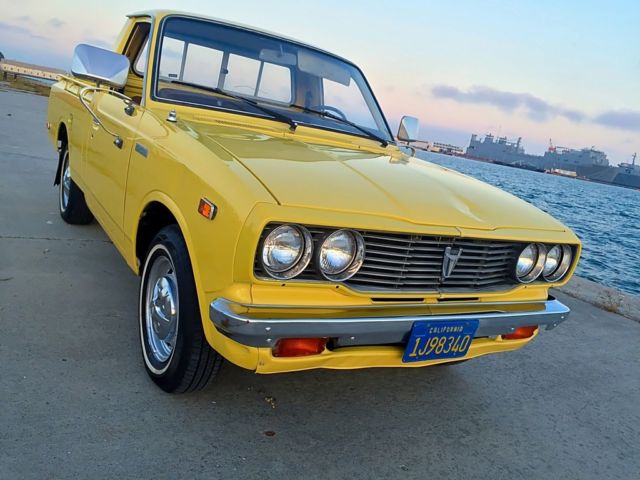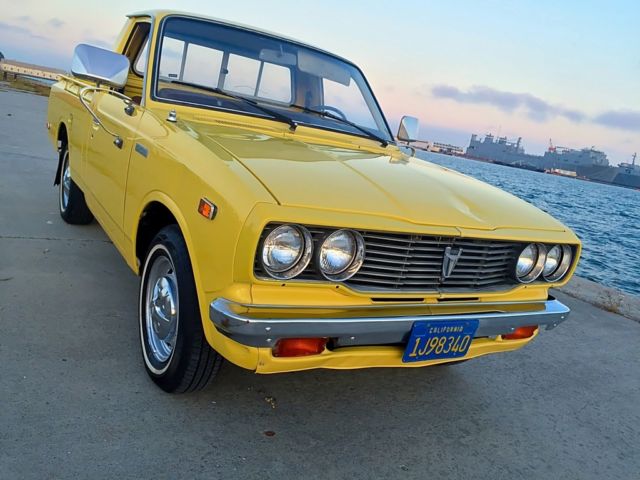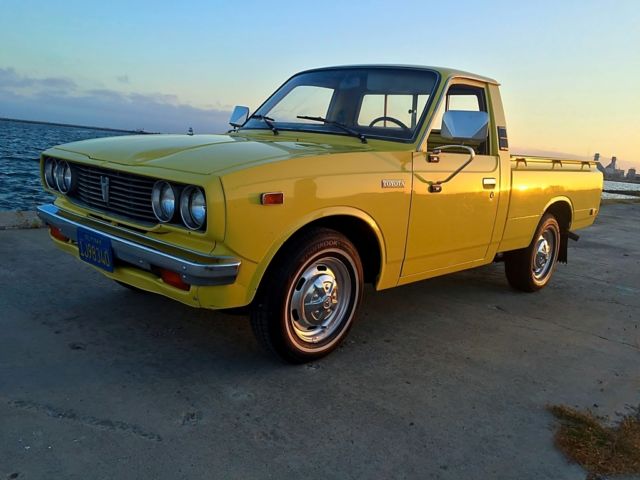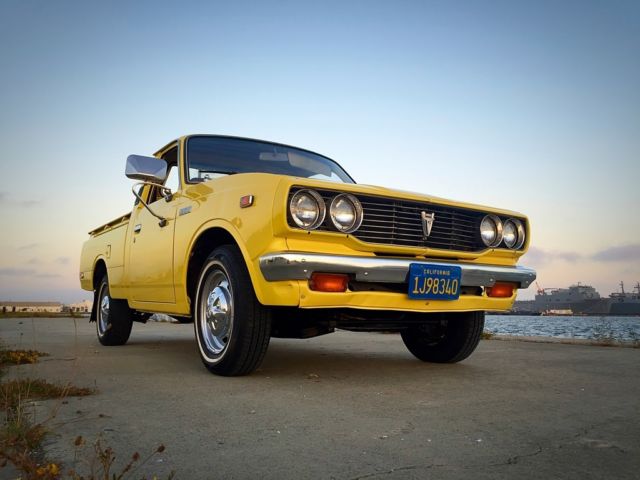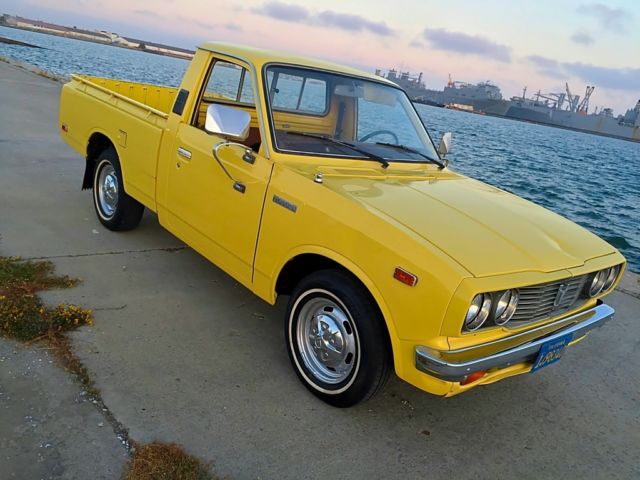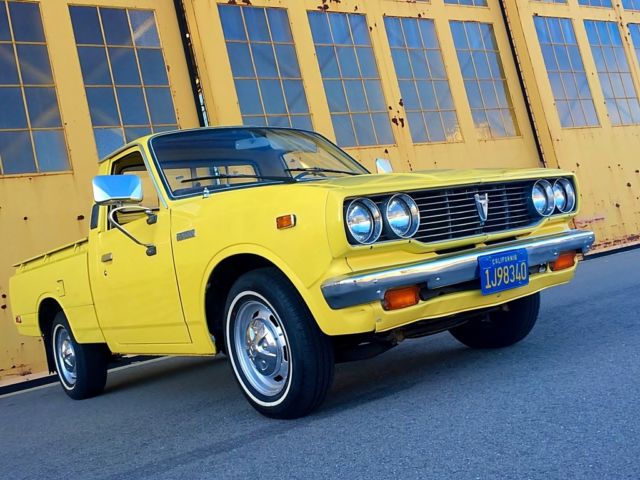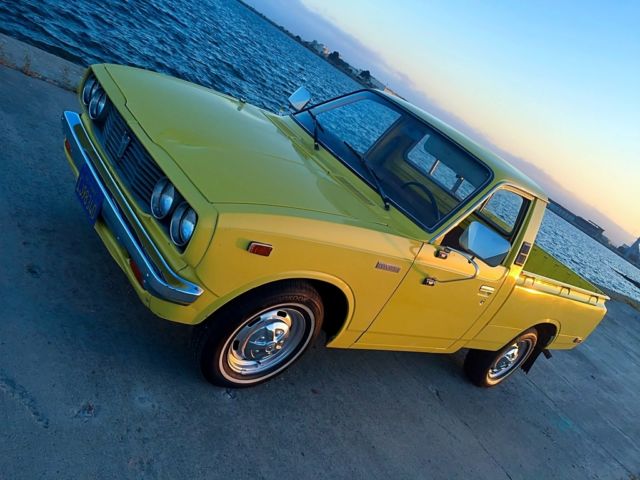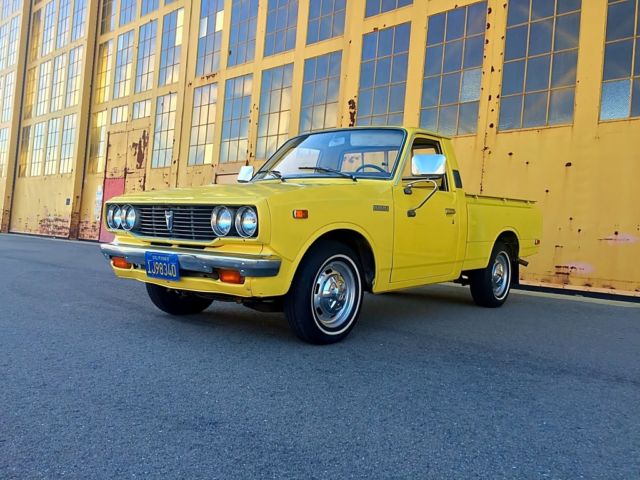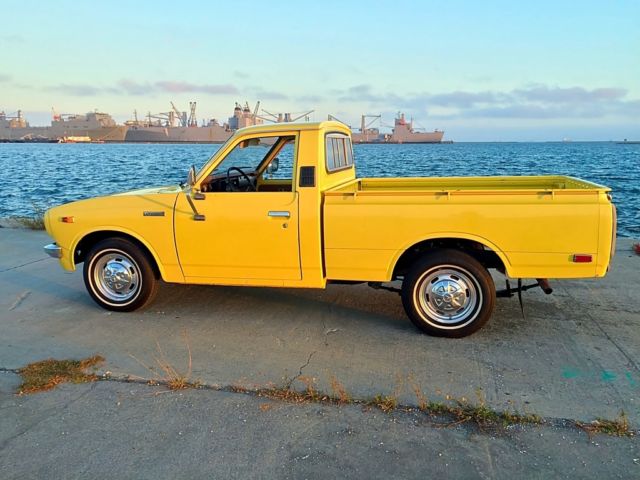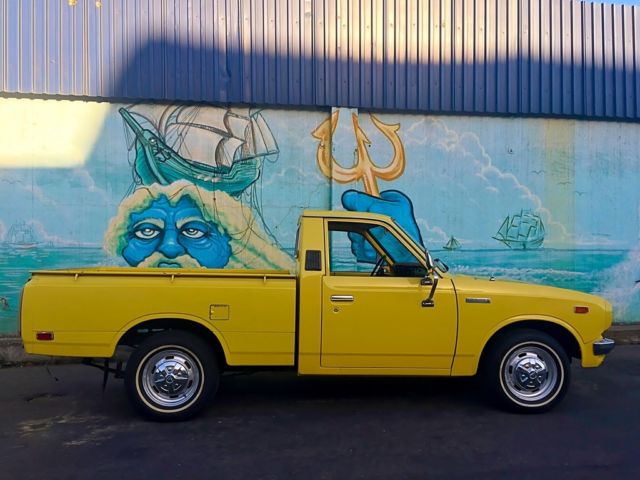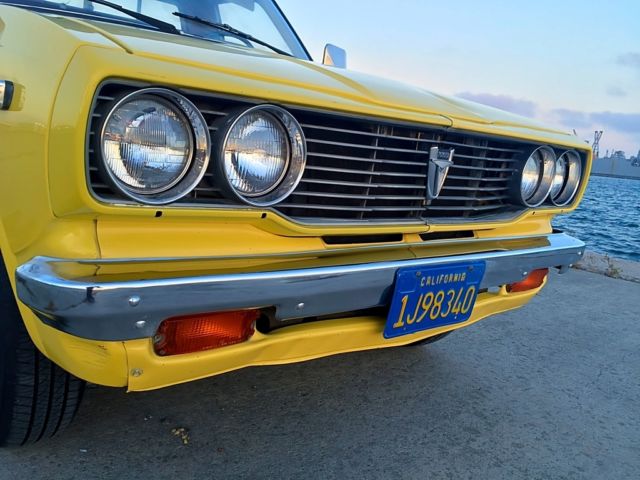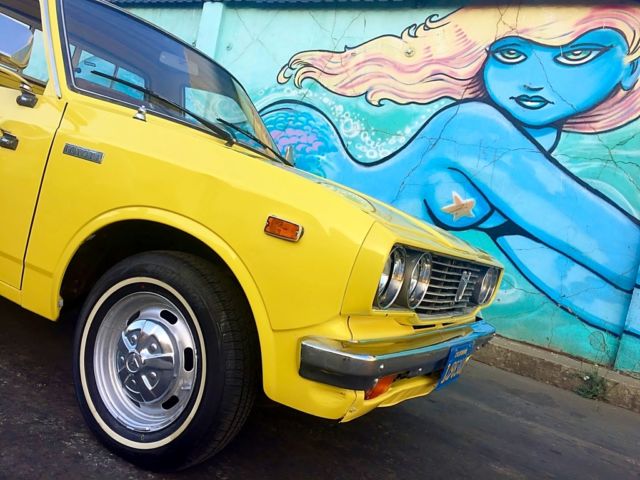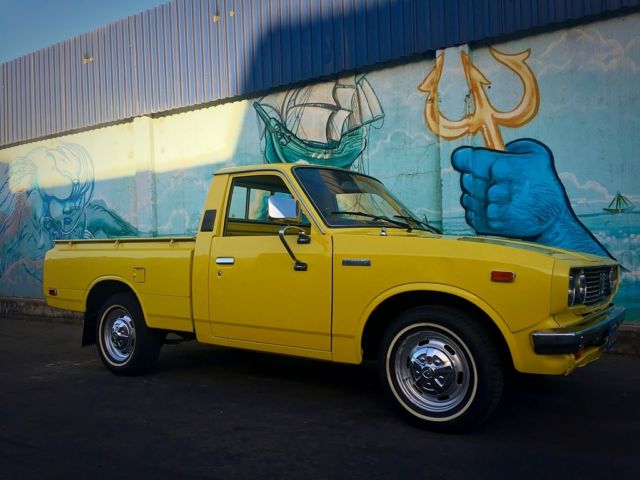1978 Toyota Hilux California Barn Find 41k Original Miles 2nd Gen RN20 20R
- Make: Toyota
- Model: Pickup
- Type: Standard Cab Pickup
- Trim: Hilux Standard Cab Pickup 2-Door
- Year: 1978
- Mileage: 41,409
- VIN: RN23077335
- Color: Yellow
- Engine size: 2.2L 2189CC l4 GAS SOHC Naturally Aspirated
- Number of cylinders: 4
- Fuel: Gasoline
- Transmission: Manual
- Drive type: RWD
- Interior color: Tan
- Vehicle Title: Clear
- Interested?
1978 Toyota Pickup Hilux Standard Cab Pickup 2-Door Description
1978 TOYOTA PICKUP~Time Capsule~One of a kind 41k mile survivor~Out of a Pasadena Estate in storage for years~Original Paint "Suntan Yellow" (#510) and interior~SOHC 20R 2.2L 4 cylinder paired with 5 speed~A 1 owner California barn find driven on average 1,051 miles per yearNO RESERVE AUCTION
Up for bid is a rare once-in-a-lifetime opportunity to purchase a time capsule a 1978 Toyota Hilux pickup with only 41,400 original miles. The original Pasadena, California owner who owned several vehicles passed away in 2013 at 84 years old.
This particular little Toyota was purchased by him from Toyota of Pasadena almost 40 years ago. Herarelyused it but kept it around because he really liked it and nicked named it Ol' Yellar. It will come with his custom "Old Yellar" Tums holder included with the original owners manual and warranty book in the glove box.
This truck is all original and has lived a very easy almost 4 decades in pleasant Pasadena and still sports the original "Suntan Yellow" paint as well as the original vinyl seat and vinyl floor mat it left the Hamura Tokyo factory with in 1978. As well as the Blue California plates issued to this car in early 1978. It landed in Long Beach and has never left sunny California so rust has never been an issue and the undercarriageis as clean as the top.
The engine is the bulletproof 20R four cylinder with just 41,400 original miles. This is the same type of Toyota engine that has set records traveling over one million miles. I am not sure how many 20R powered Toyota pickups out there with only 41k miles but this could be a record as well and makes this example quite unique .
In the 1970's mini trucks from Japan were the hot ticket in California and millions were sold. The success of the Japanese imports in this era converted another country to by Japanese cars and trucks. I am sure many are still on the road but am certain one in this condition is impossible to duplicate. This truck was designed for the California emissions unleaded fuel which were different than the other 49 states and still has the little "catalyst" sticker on the windshield and the "Long Beach Fabricators" sticker on the front of the bed near the cab and have given a detail of what that is below. This truck is a time capsule frozen in time and is inamazingly clean original condition for a 39 year old vehicle.
It is powered by the legendaryToyota 20R 4 cylinder paired with the optional 5-speed manual. The hood does have a dent and it has several small dings and dents in different spots but is a real time capsule. I have no idea when the truck was last driven, the original owner died 4 years ago and the California registration expired in 2012. It was stored with no gas and we put 5 gallons in it checked the coolantand oil and fired it up. It runs quite well and shows to be very well maintained.
yota - YouTube
Video will open in a new window
[isdntekvideo] I have described this vehicle to the best ofmy knowledge and have included over 100 Photos as well as a video. Rememberit is 39 year old truck and if you have any SPECIFIC questions please don't hesitate to ask.Thank You and GOOD LUCK!It is priced to sell with a NO RESERVE, feel free to make an offer but please don't ask what I will take to end the auction.
Video of this Truck running and driving
yota - YouTube
Video will open in a new window
[isdntekvideo]The Famous Pixar Studios Representation
Every Pizza Planet Truck Sighting in Pixar Films (1995 - 2013) - YouTube
Video will open in a new window
[isdntekvideo]The Pixar Planet planet delievery truck, first seen in the original Toy Story, makes a cameo in almost every Pixar film in the last 16 years.
Here is a chance to own your very own.
Historical
In May 1972 the 1973 model year HiLux was released as the RN20, Nicknamed the Rocket HiLux. The HiLux was radically redesigned 2nd generation in 1975 to be larger with incresed standard equipment. In North America the new version also meant the intrduction of the considerably larger 20R single overhead cam 2.2L engine. a five-speed transmission became optional. In North American, the Hilux name was fully phased out in favor of "Truck" by that year, having been dropped from brochures and advertising starting in 1973. Some North American motor-coach manufactures began building Toyota motor-homes with this chassis
Japanese automobile imports exploded in the 1970's as the American automobile industry was severely affected by the Arab embargo and the 1973 oil crisis. Small fuel-efficient cars from foreign automakers took a sharply higher share of the U.S. auto sales market. American manufacture were not geared up for affordable gas savers and imports (starting in California) were what people bought. In 1969, imports had increased their share of the U.S. auto market, with Volkswagen selling 548,904 vehicles, followed by Toyota with 127,018 vehicles. In 1981, Japanese entered into a so-called "Voluntary restraint agreement" limiting the number of autos that they could import to the U'S' to 1.68 million per year.
The Japanese mini trucks from Toyota, Datsun were all the rage and very popular sellers so much that Ford bought into Mazda to have a mini truck called the Courier and General Motors bought into Izuzu to market the Chevy Luv "light utility vehicle" and Dodge bought into Mitsubishi to have Dodge Ram50 and later Mazda started to sell the same truck as the Courier and Izuzu started to sell the in the US as the Izuzu pup. And Mitsubishi started selling trucks as Mitsubishis. These were all very popular in California in the 1970's as low priced high quality vehicles. Trucks did not fall under the "voluntary restraint agreement" as they were shipped to the United States in cab and chassis form without the beds installed. The beds were made and painted in California and this was considered assembled in the United States. The higher profit cars like the Toyota Cressida or Honda Accord were in a artifical short supply and commanded a premium price at the dealerships where as they flooded the market with low cost pickups and put as many they could on the ships that would arrive every week.
These trucks were high quality, low price and got great gas mpg, the dealers at the time did not make much money on the trucks but made it up in the extras,(which they all had), sliding rear windows, step bumpers, after market wheels and tires, pin-striping etc. They were very hot sellers and many are still on the road. Even when the Tacoma production was done in California at the numi plant in Fremont the beds were still manufacture, painted and shipped from another location in California.
This truck still has the original "Long Beach Fabricators" sticker on the inside of the bed placed there nearly 40 years ago in Feb, 1978
I have included a history of:
LONG BEACH FABRICATORS
- It all started because of chickens. U.S. manufacturing began with an effort to duck chicken tax. Tiny truck operation was start of vast network
- Granted, that's a simplistic explanation for Toyota's manufacturing might in North America. But the truth is that it traces back to the "chicken tax" proclamation signed by President Lyndon Johnson in December 1963. The tax was aimed at Volkswagen, at the time the only automaker importing pickups into the United States. The tax, a 25 percent tariff on imported pickups, was a response to the tripling of taxes in Europe on chickens exported by U.S. farmers.
- Richard Gallio, 64, who retired in 2001 after 30 years at Toyota, joined the company in the early 1970s, just as it was about to bring its compact Hilux pickup to the United States. To avoid the chicken tax, it needed to source part of those trucks on this side of the Pacific. That decision would mark Toyota's entry into manufacturing vehicles in North America.
- The solution was to import the cabs and their powertrains but to produce the truck beds domestically, with installation taking place at the ports where the trucks entered the country.
- SOURCE GOES OFF-COURSE
- Because Long Beach, Calif., was Toyota's primary port of entry and because Toyota's U.S. headquarters were in nearby Torrance, the company sought a local source for the truck beds. That source was Atlas Fabricators, conveniently located on the north side of Long Beach and next to a rail spur. Production began in 1972.
- Gallio was one of three managers sent to Atlas to manage the Toyota side of the contract. He soon discovered that Atlas, which also was producing helicopter landing mats and napalm canisters for the war in Vietnam, was in serious financial trouble.
- "We had made this major commitment to the truck market in the United States and had spent huge amounts of money getting the dealers up and running for the trucks, which were a new product for them to sell, and we increased production in Japan and had advertising in place," says Gallio. "It was not possible to walk away from that, nor could Japan gear up quickly enough to make the beds."
- So in 1974, Toyota bought the Atlas assets — land, tools and dies and other equipment — for $2.47 million.
- "The facility was not up to Toyota standards," Gallio says. "The quality of the product was subpar. It was very risky, and Toyota Motor Sales had no manufacturing experience."
- The genteel Isao Makino, who is now 85, was president of Toyota Motor Sales U.S.A. from 1975 to 1983. He recalls: "When I got here, our manufacturing facilities were very poorly equipped — no dining hall, no place to wash hands. We had dining and washing facilities installed, which were much appreciated by the Teamsters union. The Teamsters were very happy. Having them on our side was a big help in logistics."
- In addition to installing new facilities, Toyota soon changed the plant's name to Long Beach Fabricators Inc. and later to Toyota Auto Body Co., or TABC, just like Toyota's auto body-building division in Japan. Quality improved, and Toyota expanded the plant.
- MAKE WAY FOR TOYOTA WAY
- Today, TABC produces catalytic converters and their components for the Corolla and Tacoma; steering columns and front suspension arms for the Corolla, Matrix and Lexus RX 350; and aftermarket truck bed components. Some of TABC's output is exported to Japan and Canada. It also assembles Hino commercial vehicles. Most significantly, the plant was the first site in North America where the Toyota Production System was put into place.
- "To put it as succinctly as possible, the Toyota Production System empowers employees to continuously improve their processes and eliminate waste," says Jeffrey Liker, a professor of engineering at the University of Michigan and author ofThe Toyota Way: 14 Management Principles from the World's Greatest Manufacturer,
- Liker says Toyota's system educates and equips employees so they are "engaged and motivated." He adds: "It takes a lot of discipline and well-trained and highly committed employees who think about processes and how to do them better."
- InThe Toyota Way, he notes that when Toyota decided to shift truck bed production to a plant in Mexico in 2001, instead of laying off workers at TABC, Toyota rewarded their high quality of work by bringing in the Hino truck. "So instead of 600 laid-off workers collecting unemployment," he writes, there was celebration.
- Says Gallio: "The concept of the Toyota Production System is not brain surgery." But he adds that it is "just almost impossible for most cultures to implement it, how it's organized and how you have relationships with supply partners ... tightly integrated, very focused, shared objectives and great communications."
- The contrast, he said, is the typical business practice of adversarial relationships with suppliers, even with a company's own distribution and dealer network.
- "In the Toyota system, you treat everyone like you would treat your wife," he says. "You respect each other."
- 20R
- Introduced in 1975 in the Celica, Corona, and Half-ton Pickup, the 20R engine used a semi-hemispherical head design for optimal fuel-burning and power generation at high rpm; it was however designed to meet and beat emissions standards as well, without the power-sapping add-ons other manufacturers were resorting to. The 20R was a 2.2 liter (2189cc) single-overhead cam (SOHC) design, using an aluminum alloy cylinder head with cross-flow design to reduce premature fuel vaporization (surging) and percolation (flooding) in hot weather.
Externally, the 20R featured both an electric fuel pump (still unusual at the time) for steady fuel delivery and to avoid vapor lock, coupled with a better fuel return system that smoothed idling by keeping a constant supply of fuel at a more even pressure and temperature. The two-barrel downdraft carburetor featured a coolant-driven automatic choke, for more even operation.
The 20R also used electronic ignition, whose worldwide first use was in 1971 (by Chrysler Corporation); by no means was this system commonplace. The 20R was used with a larger, more efficient three-row radiator core and seven-blade viscous-driven fan to prevent overheating.
Because of its new design with emissions in mind, the 20R engines required "less tubing and plumbingâ€and fewer moving parts, yet emissions were well within regulations when introduced in 1975. Part of the improvement was in the air injection system itself, which was still used. A catalytic converter was used on Corona and Celica in the United States, but not the half-ton, which could use either regular or low-lead gas; the cars, due to the converter, had to use unleaded (but regular unleaded).
Toyota claimed more usable power than with the 18R, because maximum torque was achieved at about 55 mph in fourth gear (which was a function of both engine and gearing); and claimed that the 20R was simpler, more durable, and easier to maintain than the 18R.
The 20R was coupled to a five-speed or four-speed synchromesh manual transmission, depending on model
Classic 70's Toyotaadvertisements
1978 Toyota Half Ton Pickup Truck Commercial - YouTube
Video will open in a new windo
Toyota 'Truck-A-Thon' Dealership Commercial (1978) - YouTube
Video will open in a new window
[isdntekvideo]I have described this vehicle to the best ofmy knowledge and have included over 100 Photos as well as a video. Rememberit is 39 year old truck and if you have any SPECIFIC questions please don't hesitate to ask.
Thank You and GOOD LUCK!It is priced to sell with a NO RESERVE, feel free to make an offer but please don't ask what I will take to end the auction.
TERMS OF SALE
I RESERVE THE RIGHT TO:
- Obtain and verify the registered information of all users who bid on this auction
- Cancel any and all bids at my discretion or end the auction early if necessary
- Bidders Age: You must be 18 years of age or older to bid
- Special eBay Bid Retraction Rules: Please read eBay's "Retracting a Bid"
- Your bid constitutes a legally binding contact to purchase this vehicle. Please read eBay's User Agreement
- If you place a bid before the last 12 hour period of the auction, you may retract that bid before the last 12 hour period but only for exception circumstances. You will not be allowed to retract that bid during the last 2 hour period of the auction.
- If you place a bid during the last 12 hour period of the auction, you will be allowed to retract the bid for exceptional circumstances but only if you do so within one hour after placing the bid.
- Buyer will need to arrange funds or financing before pickup or shipment.
- INSPECTION: I have done my best to disclose all information known about this vehicle for auction. I welcome a buyers inspections. If you plan to have a buyer's inspection, please make sure you inspect the vehicle prior to the auction ending. Inspection fees, if any, are buyers responsibility.
- REPRESENTATIONS AND WARRANTIES MADE BY SELLER: This vehicle is being sold "as is". No representations or warranties are made by seller, nor are any representationsor warranties relied upon by bidders in making bids.
- TITLE INFORMATION: Title is in hand and clear. If payment is made by cashier's or personal check we will hold all titles for 10 days or until funds have cleared.
- All shipping charges and arrangements are buyer's responsibility. I will make vehicle available to third party shipping company hired by buyer but will not be responsible in any way for claims arising from shipping damage.
- Licensed carriers are generally insured for $3,000,000.00. We assume no responsibility for damages incurred after the vehicle leaves our location. Any claimsor other communication regarding shipment of vehicles will be between you and the shipper, not with seller.
- The amount of time it takes for delivery is dependent on the carrier. Verify with the shipper for an estimated time of arrive to be sure.
- I will contact the successful high bidder by email after the auction closes.
- Successful high bidder MUST communicate with seller through eBay within 24 hours of the auction ending to make arrangements to complete their transaction. If we cannot confirm your intention to buy or the sale is not completed within 5 days, we reserve the right to relist this vehicles or sell to any other qualified buyer.
- In order to secure bidon vehicle, successful bidder (buyer) must within 24 hours of bid closing send to seller a non-refundable deposit in the amount of $500.00 via PayPal. Within 72 hours of bid closing, buyer must send balance of funds by bank wire transfer, cash in person, or bank certified funds to seller.
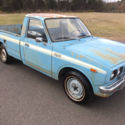 Baby blue 1973 Toyota Hilux BARN FIND pick up truck with 47,000 ACTUAL MILES!!!!
Baby blue 1973 Toyota Hilux BARN FIND pick up truck with 47,000 ACTUAL MILES!!!!
Mileage: 47,148
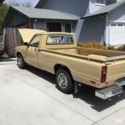 1981 Toyota HiLux Longbed 51,478 Original Miles California Truck!
1981 Toyota HiLux Longbed 51,478 Original Miles California Truck!
Mileage: 51,478
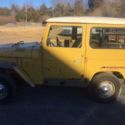 Barn Find, One Owner! - Unrestored and Original 1976 Toyota Landcruiser FJ40 FJ
Barn Find, One Owner! - Unrestored and Original 1976 Toyota Landcruiser FJ40 FJ
Mileage: 56,000
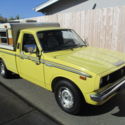 1978 Toyota Truck,COLLECTORS THIS IS PROBABLY THE NICEST ORIGINAL YOU WILL FIND
1978 Toyota Truck,COLLECTORS THIS IS PROBABLY THE NICEST ORIGINAL YOU WILL FIND
Mileage: 88,000
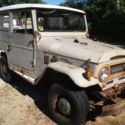 69 FJ40 Toyota Land Cruiser Running Barn Find w Original Paint LandCruiser in NJ
69 FJ40 Toyota Land Cruiser Running Barn Find w Original Paint LandCruiser in NJ
Mileage: 30,000
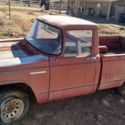 1967 Toyota Stout 1900 Pick Up Truck Rare. Original.Barn Find.
1967 Toyota Stout 1900 Pick Up Truck Rare. Original.Barn Find.
Mileage: 47,758
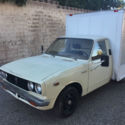 1978 Toyota Hilux Pick Up Box Truck 20R
1978 Toyota Hilux Pick Up Box Truck 20R
Mileage: 10,112
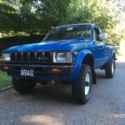 Stunning 1982 Toyota Pickup Hilux 4x4 - A rare find!
Stunning 1982 Toyota Pickup Hilux 4x4 - A rare find!
Mileage: 76,401
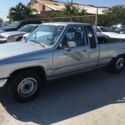 Toyota Hilux Extra Cab Pickup only 122,000 original miles Very Solid
Toyota Hilux Extra Cab Pickup only 122,000 original miles Very Solid
Mileage: 122,000
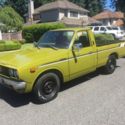 1975 TOYOTA HILUX PICKUP SR5 20R ORIGINAL OWNER 61K MILES
1975 TOYOTA HILUX PICKUP SR5 20R ORIGINAL OWNER 61K MILES
Mileage: 61,199
